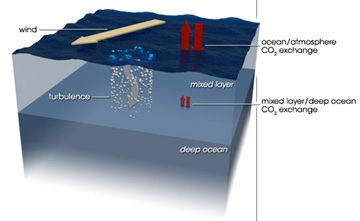When you’re cruising along in an airliner, one of the last things you want to hear the captain say is, “Sorry, folks, we’re about to hit a little turbulence.”
But while turbulence in the sky is not a good thing, turbulence in the oceans is. It’s good for the organisms that live there, it’s good for the planet, and it’s good for us.
 Turbulence helps oceans absorb CO2 from the atosphere. Credit: NASA.
Turbulence helps oceans absorb CO2 from the atosphere. Credit: NASA.Turbulence at the surface of the oceans has several causes. Winds create ripples that travel both outward and downward. Currents moving in different directions stir up eddies. Daytime heating and nighttime cooling cause the water to move up and down. In shallow waters, currents become turbulent as they drag along the bottom. And the daily up-and-down migration of small organisms may stir things up, too.
Most of this turbulence is pretty small-scale — it’s nothing like the moving pockets of air that are strong enough to bounce around hundred-ton jets.
Yet ocean turbulence is constant — ripples and eddies and streamers are always stirring things up.
The constant stirring dredges up colder, nutrient-rich waters from below. That provides food for tiny organisms at the top of the ocean food chain, which in turn feed other organisms all along the chain.
Turbulence also helps transfer heat between the oceans and the atmosphere, which allows the oceans to regulate temperatures across the globe. And it helps the oceans absorb carbon dioxide from the atmosphere, reducing the amount of the heat-trapping gas that’s in the air — making the ride a little smoother for all of us.

